
The microfinance industry (MFI) in the country added 80 lakh new women clients to its fold during 2022-23, taking the total number of low-income women clients to 6.64 crore across 729 districts through 12.96 crore active loans as of March 2023, according to India Microfinance Review FY23 report.
In FY23, the microfinance industry saw growth in portfolio outstanding as well as improvement in portfolio quality when compared with FY22 – an ideal situation with augurs well for the sector. The total portfolio of the microfinance industry as of March 31, 2023, was ₹3,48,339 crore of all Regulated Entities (NBFC-MFIs, Banks, SFBs, and NBFCs) under the MFI Model.
There has been a consistent trend of growth in the portfolio over the last 5 years barring the Covid period. Last financial year saw a growth of 22 per cent in the outstanding portfolio of the sector, indicating responsible growth and latent demand for microfinance, it added.
Overall, the sector has grown by more than 20 times to ₹.3.48 lakh crore in March 2023 from ₹17,264 Cr in March 2012.
- Also read: Microfinance sector reports improved post-pandemic growth, repayments
NBFC-MFIs
As of 31 March 2023, 211 entities were active in the microfinance space. With 82 organisations, NBFC-MFIs were the largest provider of micro-credit
“With a commanding 39.7 per cent share in the industry’s portfolio, NBFC-MFIs play a pivotal role in driving microfinance. The significant loan outstanding of ₹1,38,310 crore exemplifies their robust contribution to financial inclusion and empowerment,” said Vikas Singh, CEO and Co-Founder, Sugmya Finance Pvt Ltd, a Delhi-headquartered NBFC.
Regional distribuion
On a regional level, the distribution of portfolio continues to show a declining trend of share of East and Northeast, while all other regions (North, West, Central, and Southern) have gained in portfolio share.

Portfolio growth in Top 10 states
- Also read: Microfinance industry is expected to grow at 28% in FY24: CareEdge
The overall share of East and Northeast came down from 37.7 per cent as of March 31, 2022, to 34.9 per cent as of March 31, 2023, despite the rise of Bihar as the top state in terms of portfolio outstanding as of December 31, 2022, and also Jharkhand which has shown impressive growth. Growth in these two states was negated by the de-growth of Assam and West Bengal portfolios. Manipur may degrow further in the coming months due to the ongoing strife.
South, which used to be the hub of microfinance before the Andhra Pradesh crisis happened, is fast catching up with East and Northeast. South is expected to grow further with the opening up of opportunities in Andhra Pradesh and Telangana.
The average ticket size for microfinance loans disbursed during FY 22-23 was ₹41,391, a y-o-y increase of 6.3 per cent when compared with ₹38,929 in FY22.
The CAGR of average ticket size over the last three years (FY20 to FY23) has been 6.3 per cent , and it is the above-₹125K bucket that has shown the highest CAGR of 6.9 per cent. The y-o-y growth in the above-125K bucket has been the highest across all regions except the South. However, the y-o-y growth in average ticket size has been highest for the South at 13 per cent followed by 10 per cent for the West, and in the East & Northeast, it has decreased by 1 per cent
volume terms
The proportion of loans (in volume terms) in less than ₹30,000 bucket has fallen from 45 per cent to 31 per cent in FY23. Almost all regions have seen a drop in this bucket. However, in the East and Northeast regions, the ₹.30,000-50,000 ticket size and in the Southern region the ₹50,000-100,000 has seen a sharp increase. West Bengal witnessed a jump of almost 20 per cent in the ₹30,000-50,000 bracket. Similarly in Southern states, Kerala and Tamil Nadu saw an increase in ₹50,000-100,000 ticket-size loans.
Microfinance being a high-touch business, loan officers and field staff are the pillars on which the industry rests. As of March 31, 2023, the aggregated employee strength of all MFIN member MFIs was 1,61,010, an increase of 16.2 per cent over March 31, 2022.